Table of Contents
Kiosks – What Are They?
Kiosks are easy to define but also confusing. Round structures in Turkey where village notices were published is the origin.
And then came computers and electronic kiosks. The problem comes in whether you consider them from a functional sense, or from a vertical market sense. Companies like NCR like it when their overall numbers for self-service go up when it is a POS terminal. Many will refer to mall kiosks but those are more accurately RMUs or remote merchandising units. They are not electronic kiosks though many of those RMUs use kiosks.
It can be confusing.
Generally a kiosk is a single platform/screen where a single user views and/or interacts with it at a time. Exceptions exist and can be immigration or border kiosks where the officer also has a screen to work with and monitor. Sometimes you have two-sided kiosks (front and back).
The ATM market has worked very hard to brand their “kiosks” as “ATMs” and as the kiosk industry we generally respect that. The fact is though, on a functional level, an “Automated Teller Machine” is a kiosk. Maybe “Remote Automated Teller” would have been more descriptive but “RAT” isn’t a desirable acronym. ATMs are the same as a photo kiosk or a Bill Pay Station or any other number of vertically-named “kiosks.” Nowadays people refer to Bitcoin ATMs. In a legal sense ATMs are “money transmitters” and saying Bitcoin ATM instead of Bitcoin Kiosk, adds a certain perception that deployers prefer.
Self-service is a primary criteria. That gets into attended, unattended, and McDonalds-Europe “semi-attended”. Cardholder activated terminals are the class in PCI SSC.
Old Definitions
- From Cambridge — a small building where things such as candy, drinks, or newspapers are sold through an open window
- Oxford — a small shop, open at the front, where newspapers, drinks, etc. are sold. In some countries kiosks also sell food and things used in the home.
- Etymology — 1620s, “kind of open pavilion” (made of light wood, etc., often supported by pillars), from French kiosque (17c.), which is (along with German and Polish kiosk) from Turkish koshk, kiöshk “pavilion, summer house,” from Persian kushk “palace, villa; pavilion, portico.” They were introduced in Western Europe 17c. as ornaments in gardens and parks. Later of street newsstands (1865), on some resemblance of shape, a sense perhaps originally in French. Modern sense has been influenced by British telephone kiosk (1928).
- 1472 – Mehmed II the Conqueror built the Tiled Kiosk [see Wikipedia]
The closest “kiosks” to those might be modern-day RMUs or Remote Merchandising Units. Digital signage displays (airport departure and arrival times) centered in airport terminals are variations of the “informational kiosk”
Modern Definition
-
From Los Alamos Report 1994 –
Until recently, it was a small, rugged standalone structure often used as a newsstand, bandstand, or other commercial enterprise. The definition is evolving to include computer systems found in public places. These public computer systems are designed to provide an alternative avenue to reach information and services. The user is presented with an attractive structure that has been designed to provide a simple, friendly interface to novice computer users. It performs an easily automated task, freeing personnel from boring, tedious labor. Link
-
Types of Kiosks According To Los Alamos Report
- They are being used as a primary tool to improve the effectiveness of limited personnel and provide easy and convenient access to a wide range of services. Most of these kiosks are built to perform one of the following functions:
- To advertise a commercial product.
- To collect or dispense specific information.
- To exchange information, funds, and/or services.
- They are being used as a primary tool to improve the effectiveness of limited personnel and provide easy and convenient access to a wide range of services. Most of these kiosks are built to perform one of the following functions:
-
-
ChatGPT 2023
— It is a small, free-standing physical structure used for displaying information or selling products or services. It typically includes an interactive screen or touchpad for users to access information or complete transactions. They are commonly found in public places such as airports, shopping malls, and train stations.
-
Kiosk Industry
- A self-service kiosk or computer kiosk (some like an electronic kiosk) is a standalone terminal used by customers and employees to provide a self-service channel for general transactions. They can be informational (a wayfinding provides directions, for example), or they can be transactional (e.g., Verizon bill pay).
-
Investopedia
- Refers to a small, temporary, stand-alone booth used in high-traffic areas for marketing purposes.It is usually manned by one or two individuals who help attract attention to the booth to get new customers. Retail locations are frequently located in shopping malls or on busy city streets with significant foot traffic and provide owners with a low-cost alternative to market their products or services.
-
KioskMarketplace 2023 Census
- “An interactive, self-serve device provided by a venue, not the user, that helps the user do something that is informational and/or transactional that streamlines, automates or eliminates wait or cost.”
What They Are NOT
- For purposes of market research they are not SCOs at Krogers or Walmart. Those are hybrid POS checkouts.
- Again, for purposes of market research they are NOT ATMs, though there are now Bitcoin ATMs and those are built by kma manufacturers.
- Those nice Verizon RMUs at airports? They are not kiosks.
- Digital signage? The DS industry likes to insert the word “Interactive” but that is irrelevant for purposes of digital signage.
- EV Chargers — that gets complicated as there are multiple models and some qualify and some do not.
- Smart City? that’s borderline…

Click for full size — They think this is and while it may be in virtual use sense, it is not a kiosk
Pictures
- dmv colorado
- Click for full size image – Kiosk RedyRef
- smart city peerless av
- Digital SIgnage Cruise Ships LG
- Freestanding quick ship
- Sports Betting
- Another example
- return locker dropoff
Videos
Hotel Hospitality Kiosk (by Olea)
Marijuana Vending Kiosk

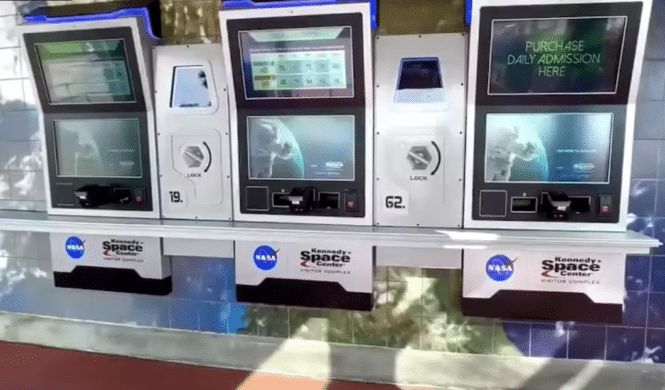
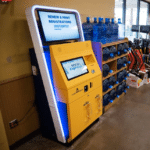
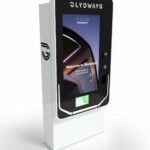


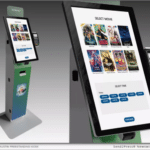
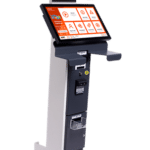
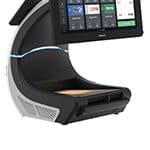
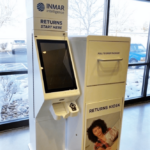
Kiosks are electronic self-service, whether customers or employees. ATMs are kiosks for all intent and purpose, but they are not built by kiosk manufacturers. Same for the grocery checkout at Whole Foods (see our article).